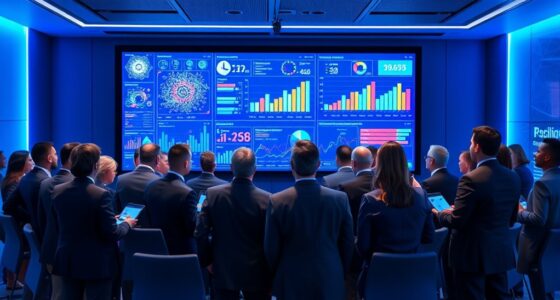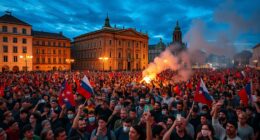Ekonomi, a term rich in diversity, represents economics and business globally. From Finnish degrees in business to Indonesian economic science, it adapts to varied cultures. Turkish history links it to the 19th-century economy, while Haitian Creole uses it in economic discussions. Understanding it reveals the economic cycle's four distinct stages: expansion, peak, contraction, and trough. Comparing it to the business cycle highlights key indicators like GDP growth and interest rates. Governments and central banks manage it through strategic policies to guarantee stability and growth. Intrigued by Ekonomi's depth and significance? The world awaits exploration of its intricate layers.
Key Takeaways
- Ekonomi varies in meaning across languages and cultures.
- Economic cycle consists of expansion, peak, contraction, and trough stages.
- Key indicators in economic cycles include GDP, interest rates, and employment.
- Governments use fiscal and monetary policies to manage economic cycles.
- Strategies aim to stabilize economies, promoting sustainable growth and stability.
Significance in Diverse Cultures
In various languages and cultures, Ekonomi holds significant importance, reflecting its diverse interpretations and applications worldwide.
In Finnish, it traditionally denoted degrees in business and economics, while in Indonesian, it represents the science of economics. Turkish usage traces back to the 19th century, associating Ekonomi with the economy.
Interestingly, in Haitian Creole, it plays a pivotal role in economic discussions. These varied linguistic contexts showcase the adaptability and universality of Ekonomi as a concept that transcends borders and resonates with people across different societies.
Understanding these cultural nuances enriches the comprehension of Ekonomi's subtleties and the ways in which it influences and shapes financial landscapes globally.
Understanding Ekonomi in Languages

Exploring the linguistic diversity surrounding Ekonomi reveals its multifaceted interpretations and applications across different cultures. In Finnish, it used to mean degrees in business and economics, while in Indonesian, it refers to the science of economics. Turkish has associated it with the economy since the 19th century.
These variations in meaning showcase how Ekonomi is understood and utilized in distinct linguistic contexts.
- Ekonomi in Finnish: Degrees in business and economics
- Ekonomi in Indonesian: The science of economics
- Ekonomi in Turkish: Associated with the economy since the 19th century
Economic Cycle Stages Explained

Understanding the stages of the economic cycle is vital for grasping the dynamics of economic fluctuations. The economic cycle encompasses four main stages that depict the overall health of an economy.
First is the expansion phase, characterized by economic growth, low interest rates, and increased employment opportunities.
Following expansion is the peak, denoting the highest growth rate attained before the economy starts to contract.
The contraction phase sees a slowdown in economic activity, leading to job shortages and lower consumer demand.
Finally, the trough marks the lowest point of the cycle, hinting at the beginning of recovery and a new growth phase.
These stages play an essential role in shaping policies, investment decisions, and predicting future economic trends.
Economic Vs. Business Cycle Comparison

Comparing the economic cycle to the business cycle reveals distinct stages and indicators that reflect the health and dynamics of an economy.
The economic cycle encompasses stages such as expansion, peak, contraction, and trough, with durations varying from 18 months to longer periods. Key indicators include GDP, interest rates, employment, and consumer spending.
On the other hand, the business cycle consists of a boom segment followed by a contraction, with the length determined by completing a full sequence of boom and contraction. The primary indicator used in the business cycle is the status of real GDP growth.
Understanding these cycles and their indicators is essential for policymakers, investors, and businesses in maneuvering economic fluctuations effectively.
Strategies for Managing Economic Cycles

Governments and central banks employ various fiscal and monetary policies to navigate and stabilize economic cycles. During periods of expansion, they might implement contractionary measures like raising interest rates to prevent overheating.
Conversely, in times of contraction, expansionary policies such as lowering interest rates and increasing government spending can stimulate growth. These strategies aim to smooth out the peaks and troughs of the economic cycle, promoting stability and sustainable growth.
Frequently Asked Questions
How Do Cultural Differences Impact the Study and Practice of Ekonomi?
Cultural differences impact the study and practice of ekonomi by influencing interpretations of economic principles. Varied linguistic meanings and historical associations shape perspectives, leading to diverse approaches in analyzing and addressing economic challenges across different societies and regions.
What Are the Historical Roots of Ekonomi in Various Languages?
The historical roots of ekonomi in various languages show diverse meanings, from business and economics degrees in Finnish to the science of economics in Indonesian. Turkish usage dates back to the 19th century.
What Are the Key Differences Between the Economic Cycle and the Business Cycle?
The economic cycle is like a marathon, with stages of growth, a peak sprint, a slowdown, and a recovery jog. In contrast, the business cycle is a sprint followed by a breather. Both impact GDP and employment.
How Can Individuals Effectively Navigate Through Different Economic Cycle Phases?
Individuals can effectively navigate through different economic cycle phases by understanding key indicators like GDP growth, unemployment rates, and inflation. Making informed decisions based on these factors and adjusting investment strategies accordingly is essential.
What Are the Key Metrics Used to Measure and Predict Economic Cycles?
When measuring and predicting economic cycles, economists rely on key metrics like GDP, interest rates, employment, and consumer spending. These indicators provide valuable insights into the health of the economy, aiding in decision-making and planning for the future.
Conclusion
As the curtains close on the intricate world of Ekonomi, one can't help but marvel at the kaleidoscope of economic principles and strategies that shape our financial landscapes.
Like a symphony with its ebbs and flows, Ekonomi orchestrates the rhythm of economies worldwide, guiding us through the peaks and troughs of economic cycles.
With a deeper understanding of Ekonomi, one can navigate the complexities of finance with finesse and insight, accessing a world of possibilities in the domain of economics.










